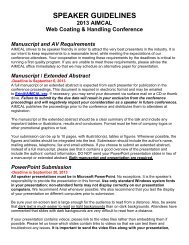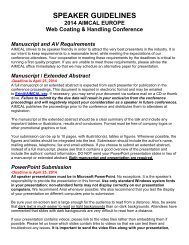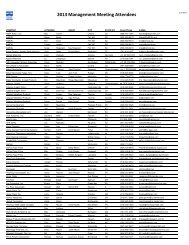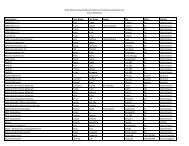Coating - Aimcal
Coating - Aimcal
Coating - Aimcal
Create successful ePaper yourself
Turn your PDF publications into a flip-book with our unique Google optimized e-Paper software.
Executive Summaries • A Look Ahead<br />
Release Liners<br />
Worldwide, release-liner market growth in 2011<br />
averaged 6-8 percent, but every region was different.<br />
An estimated 63.6 percent of the world’s release-liner<br />
markets represent the developed, mature geographic<br />
markets of north America (31.9 percent) and Europe<br />
(31.7 percent). Almost 29 percent of release-liner sales<br />
are in Asia, growing at 10 percent per annum. South<br />
America — another high-growth market with attractive<br />
future prospects — currently has a 4.6 percent share of<br />
the world market. Asia and South America will continue<br />
to grow at a higher rate than north America and Europe,<br />
with Asia soon being larger than developed geographies.<br />
Continuing high raw-material costs, margin pressure and<br />
structural change are prime issues for the release-liner<br />
value chain. The market also has been characterized<br />
recently by ongoing material- and chemical-supply<br />
shortages, rationalization and downsizing and converter<br />
consolidation.<br />
An estimated 41.3 percent of the world’s release-liner<br />
market is represented by direct coated (SCK or glassine)<br />
substrates, with 15.4, 17.0, 12.0 and 14.3 percent<br />
respectively represented by clay-coated, polyolefincoated,<br />
other papers and film substrates. Growth in SCK<br />
and glassine liner substrates is being driven primarily by<br />
the label segment, the largest release-liner application<br />
market, representing 51.5 percent of global liner usage.<br />
Film liners make up 14.3 percent of the worldwide market<br />
today. Clay- and polyolefin-coated liners (particularly in<br />
graphic arts applications) continue to penetrate specific<br />
markets where performance characteristics support their<br />
choice.<br />
There has been significant release-base downgauging<br />
of both paper and films, particularly in labelstock<br />
applications, driven both by the need for manufacturing<br />
economies and environmental, waste-reduction and<br />
recycling issues. The increasing global impact of the<br />
REACH legislation and the continuing lack of alternatives<br />
to platinum as a silicone-coating catalyst are topics of<br />
high interest.<br />
For pressure-sensitive labelstock applications, film liner’s<br />
share has grown considerably to around 20 percent today<br />
– primarily with PET as the substrate.<br />
Pressure-sensitive tapes are the second-largest releaseliner<br />
application segment, accounting for one-eighth of the<br />
total world market. Industrial applications such as building<br />
and construction, HVAC, film casting, envelopes, etc.,<br />
98 | 2012 AIMCAL SourceBook<br />
suffered as a result of the economic downturn – in both<br />
the markets for pressure-sensitive and process liners.<br />
The medical, hygiene and wound-care markets are<br />
buoyant worldwide, but Asia outpaces other world regions<br />
with medical applications alone expanding by 20-25<br />
percent per annum. These segments favor film, and there<br />
is increasing use of film liners and carriers in the global<br />
ethical and OTC wound-care market. Stoma care, surgical<br />
incision films and drapes, electrode terminals and related<br />
medical applications also are strong global liner markets,<br />
as well as the hygiene market in developing economies,<br />
where the use of disposable diapers, feminine hygiene<br />
and adult-incontinence products increases.<br />
For pressure-sensitive graphic arts applications, paperbased<br />
liners – mostly polyolefin-coated – continue to<br />
account for the bulk of this substrate’s usage.<br />
Release-liner waste management in the pressuresensitive<br />
label field is a hot issue now and will be in the<br />
future, although there is growing evidence of recycling<br />
schemes in north America and Europe involving collection<br />
and recycling of liner waste. While film liner must be<br />
sorted by polyolefin type for recycling, it is easy to handle<br />
in industrial waste-recycling processes and needs no prior<br />
treatment. “Clean” film-liner waste is commanding high<br />
prices and can represent a positive revenue stream for<br />
converters. Papers have been claimed to be the natural<br />
answer to sustainability issues in packaging, but release<br />
paper recycling is currently underutilized.<br />
Finally, there is increasing interest in linerless labels,<br />
especially for food packaging, weigh-scale and industrial<br />
barcode-labeling applications where label shape<br />
limitations are not an important factor. n<br />
By corey M. Reardon, president/ceo, AWA Alexander<br />
Watson Associates, +31-20-676-2069, email:<br />
c.reardon@awa-bv.com, www.awa-bv.com











